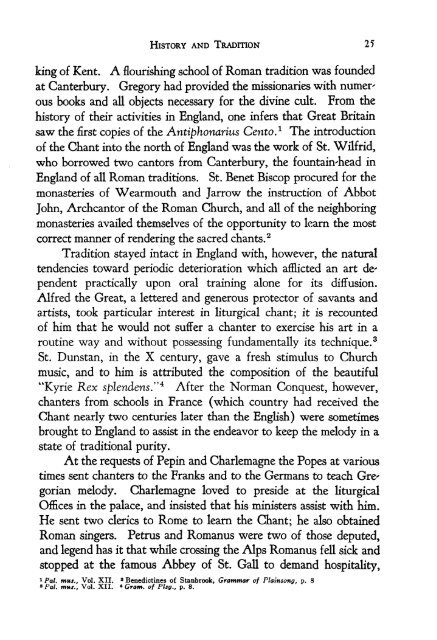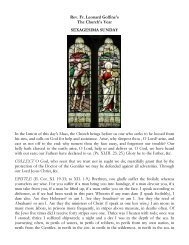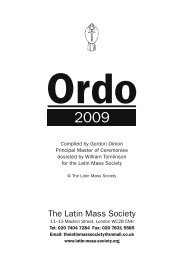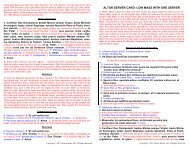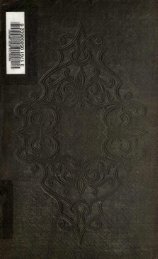The Spirit of Gregorian Chant - Church Music Association of America
The Spirit of Gregorian Chant - Church Music Association of America
The Spirit of Gregorian Chant - Church Music Association of America
Create successful ePaper yourself
Turn your PDF publications into a flip-book with our unique Google optimized e-Paper software.
HISTORY AND TRADITION 25<br />
king <strong>of</strong> Kent. A flourishing school <strong>of</strong> Roman tradition was founded<br />
at Canterbury. Gregory had provided the missionaries with numerous<br />
books and all objects necessary for the divine cult. From the<br />
history <strong>of</strong> their activities in England, one infers that Great Britain<br />
saw the first copies <strong>of</strong> the Antiphonarius Cento. 1 <strong>The</strong> introduction<br />
<strong>of</strong> the <strong>Chant</strong> into the north <strong>of</strong> England was the work <strong>of</strong> St. Wilfrid,<br />
who borrowed two cantors from Canterbury, the fountain-head in<br />
England <strong>of</strong> all Roman traditions. St. Benet Biscop procured for the<br />
monasteries <strong>of</strong> Wearmouth and Jarrow the instruction <strong>of</strong> Abbot<br />
John, Archcantor <strong>of</strong> the Roman <strong>Church</strong>, and all <strong>of</strong> the neighboring<br />
monasteries availed themselves <strong>of</strong> the opportunity to learn the most<br />
correct manner <strong>of</strong> rendering the sacred chants. 2<br />
Tradition stayed intact in England with, however, the natural<br />
tendencies toward periodic deterioration which afflicted an art dependent<br />
practically upon oral training alone for its diffusion.<br />
Alfred the Great, a lettered and generous protector <strong>of</strong> savants and<br />
artists, took particular interest in liturgical chant; it is recounted<br />
<strong>of</strong> him that he would not suffer a chanter to exercise his art in a<br />
routine way and without possessing fundamentally its technique. 3<br />
St. Dunstan, in the X century, gave a fresh stimulus to <strong>Church</strong><br />
music, and to him is attributed the composition <strong>of</strong> the beautiful<br />
"Kyrie Rex splendens." 4 After the Norman Conquest, however,<br />
chanters from schools in France (which country had received the<br />
<strong>Chant</strong> nearly two centuries later than the English) were sometimes<br />
brought to England to assist in the endeavor to keep the melody in a<br />
state <strong>of</strong> traditional purity.<br />
At the requests <strong>of</strong> Pepin and Charlemagne the Popes at various<br />
times sent chanters to the Franks and to the Germans to teach <strong>Gregorian</strong><br />
melody. Charlemagne loved to preside at the liturgical<br />
Offices in the palace, and insisted that his ministers assist with him.<br />
He sent two clerics to Rome to learn the <strong>Chant</strong>; he also obtained<br />
Roman singers. Petrus and Romanus were two <strong>of</strong> those deputed,<br />
and legend has it that while crossing the Alps Romanus fell sick and<br />
stopped at the famous Abbey <strong>of</strong> St. Gall to demand hospitality,<br />
1 Pal. tnus., Vol. XII.<br />
2 Benedictines <strong>of</strong> Stanbrook, Grammar <strong>of</strong> Plainsong, p. 8<br />
a Pal. mus., Vol. XII. * Gram, <strong>of</strong> Plsg., p. 8.


